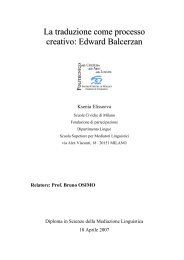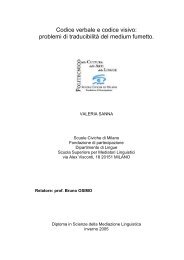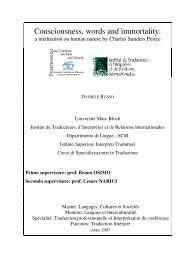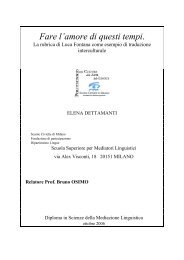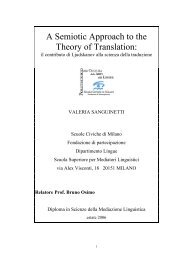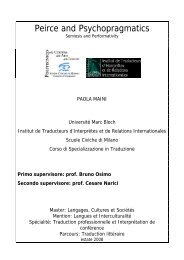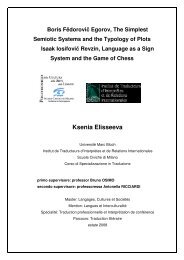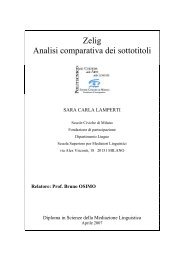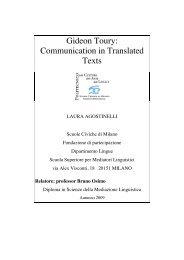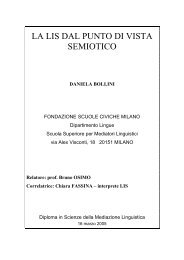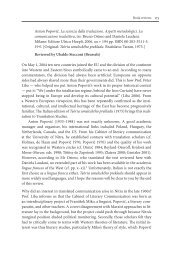Alice in Wonderland - Bruno Osimo, traduzioni, semiotica della ...
Alice in Wonderland - Bruno Osimo, traduzioni, semiotica della ...
Alice in Wonderland - Bruno Osimo, traduzioni, semiotica della ...
You also want an ePaper? Increase the reach of your titles
YUMPU automatically turns print PDFs into web optimized ePapers that Google loves.
translation, B. Conejo is not coherent with Conejo Blanco. Spaniards use<br />
two surnames, the father’s name and the mother’s name, so the whole<br />
expression Conejo Blanco would be a perfect surname, perhaps together<br />
with any <strong>in</strong>itial for a first name, e.g., F. Conejo Blanco. This is the solution<br />
the Brazilian translator has chosen, and she is lucky because Coelho Branco<br />
is, <strong>in</strong>deed, a usual surname.<br />
4.3. Names referr<strong>in</strong>g to fictitious characters<br />
It is a specific characteristic of <strong>Alice</strong> <strong>in</strong> <strong>Wonderland</strong> that, with very few<br />
exceptions (like <strong>Alice</strong>, Pat, Bill), the fictitious characters have no names <strong>in</strong><br />
the conventional sense of the word. Characters, mostly animals or fantasy<br />
creatures, are usually <strong>in</strong>troduced by a description which is afterwards used<br />
as a proper name just by writ<strong>in</strong>g it with a capital letter. For example, at the<br />
end of chapter IV we read: “She stretched herself up on tiptoe, and peeped<br />
over the edge of the mushroom, and her eyes immediately met those of a<br />
large blue caterpillar, that was sitt<strong>in</strong>g on the top with its arms folded,<br />
quietly smok<strong>in</strong>g a long hookah, and tak<strong>in</strong>g not the smallest notice of her or<br />
of anyth<strong>in</strong>g else.” The next chapter beg<strong>in</strong>s as follows: “The Caterpillar and<br />
<strong>Alice</strong> looked at each other for some time <strong>in</strong> silence…” (emphasis C.N.).<br />
White Rabbit is one of the numerous generic nouns turned <strong>in</strong>to a<br />
proper name: The White Rabbit, the Mouse, the Duchess, the Gryphon.<br />
Translat<strong>in</strong>g <strong>in</strong>to Romance languages it is easy just to follow the author’s<br />
model capitaliz<strong>in</strong>g the generic nouns. In German, however, all nouns are<br />
written with a capital first letter, therefore, capitalization cannot be used as<br />
a means to mark them as proper names. The only way out of the dilemma<br />
would have been to use the nouns without the def<strong>in</strong>ite article, but this<br />
procedure cannot be found <strong>in</strong> the German translations of our corpus.<br />
Apart from this group of names we f<strong>in</strong>d personifications of play<strong>in</strong>g<br />
cards: Five, Two or Three, together with the K<strong>in</strong>g, the Queen and the<br />
Knaves. There are no translation problems here, and the illustrations<br />
support the text, especially for readers <strong>in</strong> cultures where other k<strong>in</strong>ds of<br />
play<strong>in</strong>g cards are used.<br />
59



